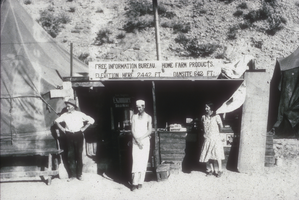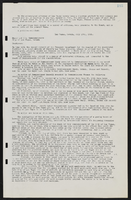Search the Special Collections and Archives Portal
Search Results
Wieking, Henry C., 1906-1998
Henry C. Wieking was born January 5, 1906 in Alameda, California. He worked as a draftsman in Oakland, California until 1929, when the United States Bureau of Reclamation hired Wieking to work in Las Vegas, Nevada. He moved to Las Vegas in approximately September of 1929, and he worked on the construction of Hoover Dam (Boulder Dam) and the reconstruction of the Las Vegas Mormon Fort. Wieking died May 25, 1998 in Pleasant Hill, California.
Sources:
Person
Thomas, Therese, 1917-2001
Therese Courture Thomas was born July 5, 1917 in Thistle, Utah. Her father, Earnest "Earl" Courture, worked as a railroad worker, a steel worker, and a building contractor as her family moved around Utah. After the Wall Street Crash of 1929, Thomas's father moved to Las Vegas, Nevada to work on Hoover Dam (Boulder Dam) construction, later moving the rest of the family with him in approximately 1931. Thomas worked as amusican in swing and dance bands. She died October 26, 2001.
Source:
Person

Transcript of interview with Neil Henry Holmes by James Greene, January 14, 1975
Date
Archival Collection
Description
On January 14, 1975, collector James Greene interviewed foreman, Neil H. Holmes (born on November 16th, 1897, in Chicopee, Kansas) in his home in Boulder City, Nevada. This interview covers the early days in Boulder City. Mr. Holmes also discusses the local education system, family life, employment opportunities, housing, and the building of Hoover Dam.
Text
Ralph Roske Photographs
Identifier
Abstract
The Ralph Roske Photographs (approximately 1917-1989) depict life in rural Southern Nevada and newspaper clippings from the Goodsprings Gazette. The collection consists of thirty-five images dated from 1917 to 1989. The images consist of unidentified Nevadans, Las Vegas landmarks, and members of the McAllister family in Carraca, Nevada.
Archival Collection
Peg and George E. Crockett Family Photographs
Identifier
Abstract
The Peg and George E. Crockett Family Photographs (approximately 1940-2008) are comprised of aerial photographs of Alamo Airport (later McCarran International Airport) and the surrounding Las Vegas Valley in the 1940s and 1950s. Photographs of the interior, exterior, and airfield at Alamo Airport document the early stages of what is now one of the busiest international airports in the United States. The collection also contains audiovisual material, which depict events including the Miss Rodeo America pageant and the Sahara Cup boat races on Lake Mead, and locations including Fremont Street in downtown Las Vegas, Nevada and Hoover Dam. A significant portion of the collection consists of photographs of the Crockett family at various events, on family vacations, and their home in Las Vegas, Nevada.
Archival Collection
Virginia Logan Photograph Collection
Identifier
Abstract
The Virginia Logan Photograph Collection contains photographic prints, negatives, and slides primarily depicting Nevada between approximately 1900 and 1940 with a focus on Las Vegas and its local landscapes. These photographs were taken by Glenn Davis.
Archival Collection
Horace Emery oral history interview
Identifier
Abstract
Oral history interview with Horace Emery conducted by Barry Sarles on March 02, 1980 for the Ralph Roske Oral History Project on Early Las Vegas. Emery discusses the local area around Nelson, Nevada and the early events that helped shape the area. Emery also discusses his work as a river boatman on the Colorado River, working on the Hoover and Davis Dams, and employment as a factory worker in Clark County, Nevada.
Archival Collection

Transcript of interview with Harvey N. Dondero by Iskander A. Batlouni, February 26, 1981
Date
Archival Collection
Description
Text

Film transparency showing the first grocery in Boulder City, Nevada, April 18, 1931
Date
Archival Collection
Description
Image

